By Andrew Warshaw
June 26 – You win some, you lose some and it’s all about interpretation. That seems to be the upshot so far of VAR’s introduction at the World Cup that reached new levels of confusion on Monday evening and continues to throw up more questions than answers.
On the positive side, most of the decisions made by VAR so far have proved to be correct – the narrow onside that earned Spain a last-gasp equaliser against Morocco being a case in point.
But for every correct ruling, there have been too many inconsistencies, making a mockery of the very reason VAR was implemented in the first place: to eliminate “clear and obvious mistakes” (in other words blunders) and help (not hinder) referees.
The problem, after a couple weeks of scrutiny, appears to be that the officials (or some of them) are running scared of being proved wrong – either by protesting players or by VAR. One or two decisions have simply beggared belief, Iran’s penalty against Portugal in the dying seconds being the prime example.
According to the rules of VAR, the process for reviewing a decision can work in two ways. Either the referee asks for a review or the VAR team can recommend one. Referees can then overturn the call based on the VAR’s advice; review the incident himself on a monitor or stick with the initial decision. Only disputed goals, penalty decisions, red cards and mistaken identity are allowed to invoke the VAR.
Taking all that into account, how on earth can Portugal’s Cedric have been adjudged to have committed a foul when he jumped to clear a lofted ball into the Portugal box? Sardar Azmoun headed the ball straight into Cedric’s arm. There was absolutely no arm-to-ball movement whatsoever. As one commentator put it, unless Cedric chopped his arms off, he couldn’t get out of the way.
It was clearly an accident but – and this is the key – Iran’s players appealed en masse for a spot-kick. After watching a replay, the referee capitulated despite having made a firm initial decision with which millions of watching fans agreed. Suddenly, wary of being watched by four experts in a studio thousands of miles away in Moscow, he gets all edgy and changes his mind.
This, in effect, is the exact opposite of why VAR was introduced. Once reviewed, the referee is supposed to still have the final say. What we don’t know in this case is whether Paraguayan ref Enrique Caceres was told he had made a mistake. I somehow doubt it. Otherwise the VAR team themselves were guilty of a clear and obvious error.
Then, in the same game, there was the Cristiano Ronaldo sending-off incident.
Before the World Cup started, FIFA refereeing chiefs pledged there would be “zero tolerance” when it came to serious foul play. Yet somehow Ronaldo got away with only a yellow after thrusting an elbow into the face of Morteza Pouraliganji.
“Why?” demanded a furious Iran manager Carlos Queiroz. “The rules don’t say if it is Messi or Ronaldo it is only a little bit of an elbow. It is a red card. What is the difference between an elbow by Cristiano Ronaldo and everyone else? Is his a half elbow? If there was some justice in football – which doesn’t exist – only one winner would have come out in this game. And that winner is Iran.”
Ah well, is that really true much as we love to root for the underdog? As I say, you win some, you lose some. Whether it should be as arbitrary as this is highly questionable but Iran’s penalty was a joke and Queiroz conveniently ignored that.
A more sinister trend suggests the inconsistencies are not just the fault of referees and that players and coaches need to take a hard look at themselves. The more crucial decisions don’t go their way, the more they are suddenly kicking up a fuss and pleading for VAR. The sight of hand gestures representing a tv monitor is in danger of becoming the latest pressure tactic and needs to be nipped in the bud, perhaps becoming punishable in itself.
Before the World Cup got under way, many experienced officials were cautious about using VAR (which, for all its laudable intentions, was still in its experimental stage) in FIFA’s flagship event.
The counter-argument (one espoused by Gianni Infantino) was that statistics proved definitively that VAR worked in terms of cutting out blunders and that the fate of teams at such an important competition can no longer be decided by blatantly wrong game-changing decisions.
Fair enough but from what we’ve seen so far, for everything that VAR has got right, too many unknown factors have suddenly crept in.
The bottom line, perhaps, is that there is an element of human error which technology on its own cannot always overcome. Ironically, that might not be such a bad thing but it depends, totally, on the nature and severity of the incident.
Contact the writer of this story at moc.l1713489540labto1713489540ofdlr1713489540owedi1713489540sni@w1713489540ahsra1713489540w.wer1713489540dna1713489540

